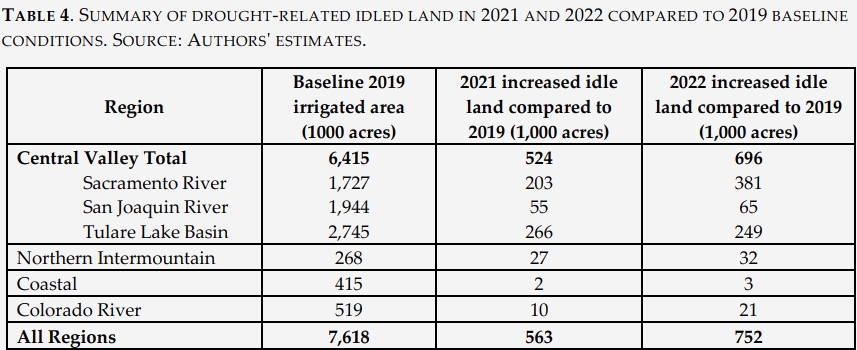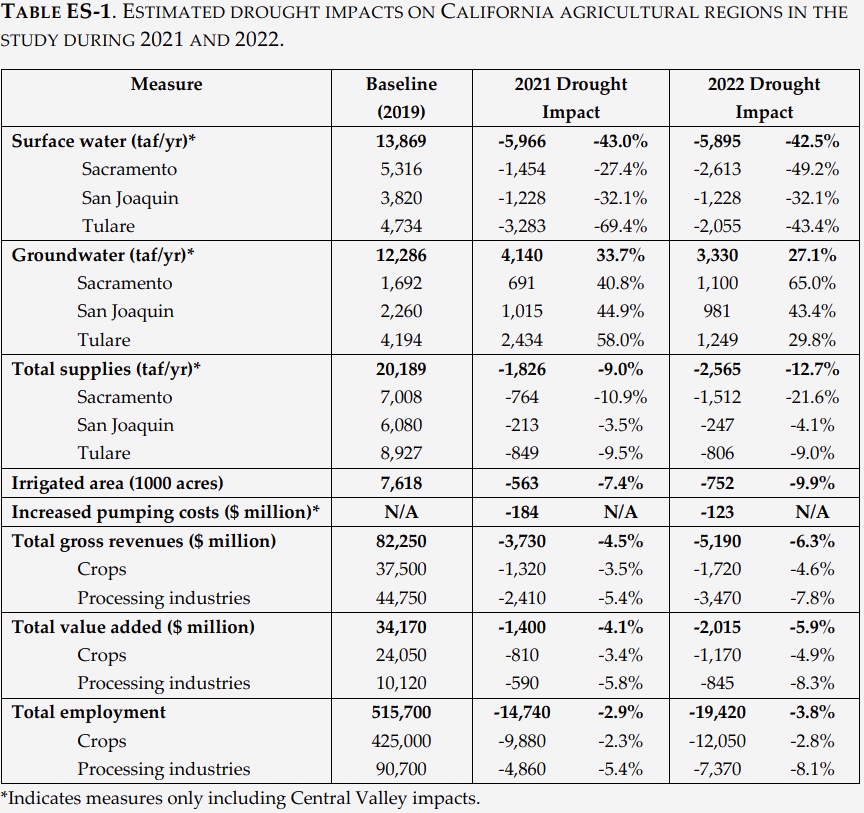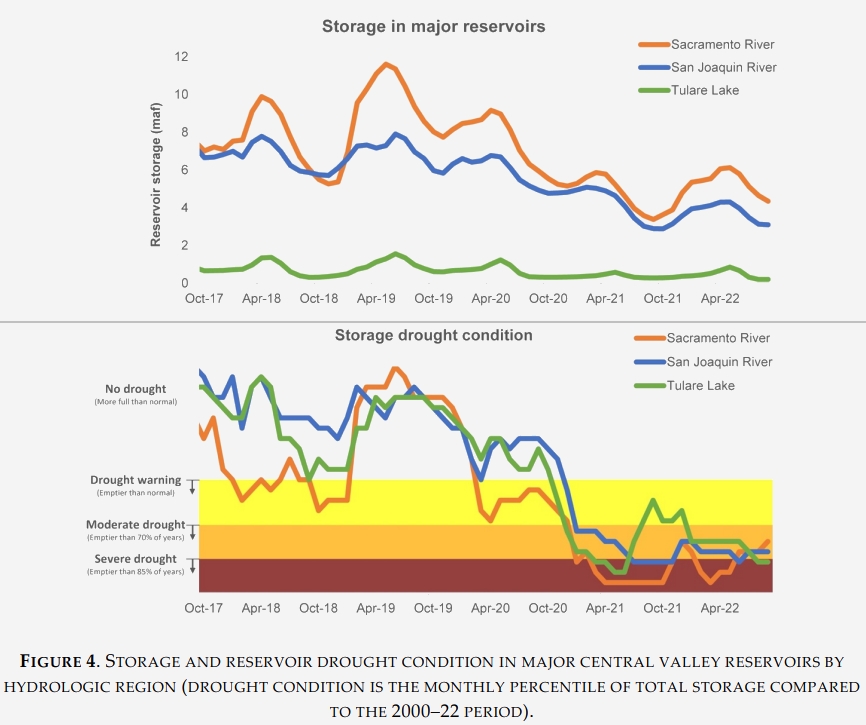Drought dramatically shrinking California farmland, costing USD 1.7 billion
Losses to California’s agricultural industry have continued to mount as the state’s drought stretched into a third straight year, according to a report released by researchers from the School of Engineering and the Public Policy Institute of California.
The report, led by Professor Josue Medellín-Azuara, estimates direct economic impacts on farm activity of USD 1.2 billion this year, up from USD 810 million in 2021 — representing a 4.9% and 3.4% impact on crop value added, respectively. “Value added” is the contribution from a sector to the region’s gross domestic product. It includes profits, compensation and taxes.
Beyond direct farm effects, impacts on food processing industries that rely on farm products were roughly USD 845 million in 2022, up from USD 590 million in 2021. Altogether these consequences total USD 2 billion in value-added losses this year alone (5.9% reduction with respect to 2019) and a loss of 19,420 jobs, the researchers calculated.
But it could have been worse, the report shows. “Findings from our study indicate drought impact mitigation actions such as land idling and increased groundwater pumping were the most common. More extensive fallowing in the Sacramento Valley, along with water trading, decreased the economic losses of a drought of this magnitude,” said Medellin-Azuara.
The 2020-2022 water years constitute the driest three-year period in California’s instrumented historical record. “California is no stranger to drought, but this current drought has hit really hard in some of the typically water-rich parts of the state that are essential for the broader state water supply,” said Professor John Abatzoglou, a coauthor on the report. “The Sacramento Valley and its communities have been ground zero during this drought,” said Alvar Escriva-Bou, a senior fellow at the Public Policy Institute of California. The report estimates that statewide idled land in 2022 increased by 750,000 acres with respect to 2019, with more than half of these farms in the Sacramento area, and a majority of them in the rice production counties of Sutter, Colusa and Glenn.

“The Sacramento Valley showed greater vulnerability this time because of the unprecedented climatological conditions, but also because there’s less groundwater pumping capacity. Given that it’s a normally wetter region, it might be wise to assess investments in recharge and pumping infrastructure to increase drought resilience,” added Escriva-Bou.
"On top of precipitation deficits, this drought has shown the importance of what some are calling an ‘evapotranspiration tax’ — increased crop water demand due to a thirsty atmosphere. Impacts of water supply deficits are exacerbated by increased irrigation needs to maintain crop productivity," said graduate students and report coauthors Spencer Cole and Jose Rodriguez. In some locations, crops such as almonds, berries and tomatoes had decreased yields due to water stress, but also because of heatwaves.
In addition to drought impacts, California’s agricultural economy also suffered from disruptions in the supply chain, including delays in shipping crops out of California. The report’s authors said those delays may result in increased inventory and could influence some of California’s specialty crop prices.
Each drought provides the opportunity to learn something to apply to the next drought, researchers said.
“We need to more fully invest in building climate resilience in our rural, agriculture dependent communities as they are on the front lines of climate impacts to their economic base,” said UC Merced Associate Dean for Research Professor Joshua Viers, also a report co-author. “We can only expect prolonged dry periods briefly interrupted by pronounced wet ones — which will further stress access to clean drinking water and steady employment, among many challenges.”
California Farm Bureau critical of state's preliminary water allocation for 2023
The California Department of Water Resources' initial State Water Project allocation for the upcoming year is 5% of 2023 water supplies requested from the SWP, California’s water and power system.
“It is going to take a multi-pronged approach to successfully respond to these unprecedented drought conditions,” Kara Nemeth, director of DWR (Department of Water Resources), said in a news release. The allocations are updated monthly as snowpack and runoff is assessed, with final allocations usually confirmed in May or June, according to the DWR.
By comparison, other low initial water allocations include 5% in 2010 and 2014. Last year, the initial SWP allocation was 10%; however, due to increasing dry conditions, the final allocation was lowered to 5%.
This minimal water allocation is unwelcome news to many California farmers, business owners and residents. “Here we go again,” California Farm Bureau President Jamie Johansson said in a news release. “This means that 23 million people and 750,000 acres of farmland are facing another year of uncertainty and economic hardships. California has failed to act on critical projects to provide additional water storage, stormwater capture and groundwater recharge that are needed to protect our farms and cities from water shortages in dry years.”
If this initial allocation remains steady, it will be the third year in a row with final water allotments confirmed at 5%, according to the release. “California’s dismal leadership in safeguarding our water resources harms our food production as consumers face rising prices at the grocery store. It also undercuts healthy crop production, which helps reduce carbon emissions that contribute to climate change. California must have a more coherent water plan. Our drought strategy cannot solely be a policy of managing scarcity,” Johansson said in the release.
Water priorities
According to the DWR, water supply priorities fall into four main categories:
 Water for health and safety needs, as well as delta salinity control.
Water for health and safety needs, as well as delta salinity control. Water for endangered species.
Water for endangered species. Water to reserve in storage.
Water to reserve in storage. Water for additional supply allocations, if possible.
Water for additional supply allocations, if possible.
“Despite a wet start to the water year, conditions have dried out since that first storm, and we are still planning for a below-average water year. That means we need to prepare now for a dry winter and severe drought conditions to continue through 2022,” Nemeth said in the release. “We will be working with our federal partners and SWP (State Water Project) contractors to take a conservative planning approach to balance limited water supplies with the needs of residents, businesses and the environment.”
Sources: ucmerced.edu, latimes.com




































